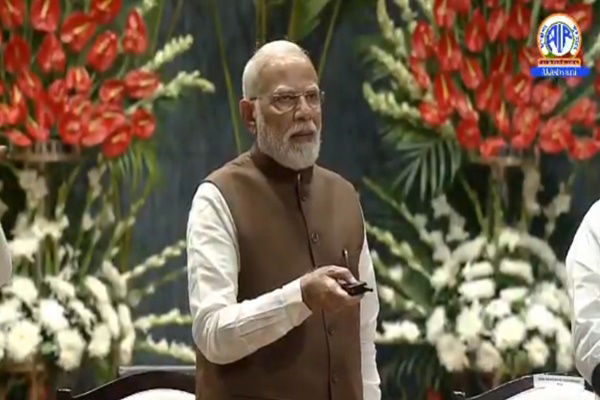PM Modi Launches ‘PM Dhan Dhaanya Krishi Yojana’ & ‘Mission for Aatmanirbharta in Pulses’

PM Modi Launches ‘PM Dhan Dhaanya Krishi Yojana’ and ‘Mission for Aatmanirbharta in Pulses’
Introduction
At a special agricultural programme held at the Indian Agricultural Research Institute (IARI), New Delhi, Prime Minister Narendra Modi launched two major national initiatives — ‘PM Dhan Dhaanya Krishi Yojana’ and ‘Mission for Aatmanirbharta in Pulses’ — with a combined outlay of over ₹35,000 crore. These programmes mark a renewed thrust on sustainable agriculture, crop diversification, and self-reliance in food security, aligning with India’s vision of Aatmanirbhar Bharat and rural transformation.
1. PM Dhan Dhaanya Krishi Yojana
Outlay: ₹24,000 crore
Objective:
The scheme aims to enhance agricultural productivity, encourage crop diversification, and modernize irrigation and credit infrastructure across 100 low-performing agricultural districts. It seeks to bridge yield gaps, promote sustainable practices, and ensure better resource utilization.Key Features:
- Focus on district-level transformation by identifying and upgrading low-productivity zones.
- Integration of modern irrigation systems and credit facilitation (both short- and long-term).
- Promotion of sustainable farming techniques — including soil health improvement, crop rotation, and precision agriculture.
- Encouragement of digital and technological interventions in farming to improve efficiency.
The scheme represents a shift from a production-centric to a productivity and sustainability-oriented agricultural model, similar in spirit to the Green Revolution’s transformative ambition but adapted for the 21st-century challenges of climate change and resource stress.
2. Mission for Aatmanirbharta in Pulses
Outlay: ₹11,440 croreObjective:
The mission targets self-sufficiency in pulse production, addressing India’s long-standing dependence on imports to meet domestic demand. It aims to boost productivity, expand cultivation, and strengthen the entire value chain — from procurement and processing to storage and loss reduction.Strategic Focus Areas:
- Expansion of the area under pulse cultivation, especially in rain-fed and semi-arid regions.
- Introduction of high-yielding and drought-resistant pulse varieties through enhanced R&D.
- Strengthening storage and processing infrastructure to reduce post-harvest losses.
- Integration with Minimum Support Price (MSP) and procurement frameworks to ensure fair returns for farmers.
This mission directly contributes to protein security, echoing the government’s emphasis on “nutrition-sensitive agriculture”, while also diversifying India’s agricultural base beyond rice and wheat.
3. Complementary Projects and Investments
In addition to the two flagship initiatives, the Prime Minister inaugurated projects worth ₹5,450 crore across the agriculture, animal husbandry, fisheries, and food processing sectors, and laid foundation stones for additional projects worth ₹815 crore. These investments reinforce a holistic rural economy model, integrating the entire farm-to-market ecosystem.
4. Broader Agricultural Achievements Highlighted
Prime Minister Modi noted several achievements of the past decade that provide context for these new schemes:
- Agricultural exports have nearly doubled in 11 years.
- Foodgrain production has risen by approximately 90 million metric tonnes.
- India ranks first globally in milk production and second in fisheries.
- Establishment of six new fertilizer plants and distribution of 25 crore soil health cards.
- A sixfold increase in agriculture budget under the NDA government.
- Over ₹3.9 lakh crore transferred under PM-Kisan Samman Nidhi and ₹1.83 lakh crore disbursed under PM Fasal Bima Yojana.
5. Policy Rationale and Expected Impact
(a) Crop Diversification and Climate Resilience
By encouraging farmers to move beyond the rice–wheat monoculture, the new schemes aim to address challenges of soil degradation, groundwater depletion, and nutrient imbalance. Promoting pulses can improve soil fertility through nitrogen fixation and make Indian agriculture more climate-resilient.
(b) Self-Reliance and Import Reduction
India currently imports a significant portion of its pulses. Achieving Aatmanirbharta in pulses will reduce import bills, stabilize domestic prices, and enhance food sovereignty.
(c) Localized Agricultural Reform
By focusing on 100 underperforming districts, the scheme aligns with the “Aspirational Districts” model, fostering localized planning and accountability — a pragmatic shift from one-size-fits-all policies.
(d) Technological and Financial Integration
The combination of irrigation, digital farming, and credit facilitation promotes modernization at the grassroots. The government’s emphasis on financial inclusion and DBT frameworks ensures transparent fund flow and direct farmer empowerment.
6. Challenges and Implementation Concerns
While the schemes are ambitious, their success depends on:
- Effective coordination among central and state agencies.
- Streamlined credit disbursement and monitoring mechanisms.
- Capacity-building of local agricultural extension services.
- Ensuring climate adaptability of new pulse varieties.
- Preventing regional disparities in scheme implementation.
Conclusion
The launch of PM Dhan Dhaanya Krishi Yojana and Mission for Aatmanirbharta in Pulses reflects India’s evolving agricultural policy — one that balances productivity, sustainability, and self-reliance. Together, they signify a strategic shift from input-based subsidies to outcome-based empowerment, positioning agriculture not merely as a sector of survival but as a pillar of India’s developmental and nutritional sovereignty.
Updated - October 11, 2025 8:22 PM | News On Air